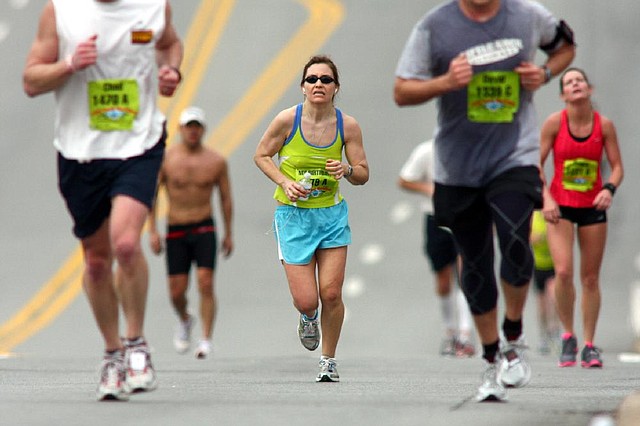Race pace review: Women beat men
Arkansas Democrat-Gazette/STEPHEN B. THORNTON 3/7/10 Sarah Meyer, center, of Indianapolis, Ind., struggles with other runners up the final hill along Cantrell Road in the 25th mile during Sunday morning's 2010 Little Rock Marathon.
Monday, August 18, 2014
During marathons, women pace themselves more evenly than do male competitors, according to a study of thousands of racers.
The results provide unexpected insights into some of the physical and emotional differences between male and female runners, and also how both sexes might improve their race times by noting how the other one runs.
Anyone who has competed in or seen a marathon knows that maintaining a steady speed throughout the 26.2 miles is advisable. People who start the race at a fast pace generally have to slow and even walk or zombie shuffle as the race goes on.
A few small studies and many anecdotal observations had suggested that men were more apt than women to start fast but wind up slowing. But no large-scale examination of marathon racers had confirmed that.
So for the new study, which was published in July in Medicine & Science in Sports & Exercise, researchers at Marquette University in Milwaukee; the Mayo Clinic in Rochester, Minn.; and Grand Valley State University in Allendale, Mich., began by gathering data about the finishers at 14 marathons. The races included prominent ones, such as the Chicago and Disney marathons, and smaller events. Some were conducted in warm weather, others in chilly conditions,
with terrain ranging from hilly to pancake-flat.
The researchers wound up with information about 91,929 marathon participants, almost 42 percent of them women. The data covered all adult age groups and a wide range of finishing times.
They then compared each runner's time at the midpoint of the race with that racer's finish time, a simple method of broadly determining pace. If someone covers the second half of a race in about the same time as the first, then pace is relatively even, with little slowing. (Only rarely does someone speed up in the second half of a race, running what is known as a negative split.)
As it turned out, men slowed significantly more than women. In aggregate, men covered the second half of the marathon almost 16 percent slower than they ran the first half. Women, as a group, were about 12 percent slower in the second half.
Burrowing deeper into the data, the scientists categorized runners as having slowed markedly if their second-half times were at least 30 percent slower than their first-half splits. In concrete terms, a racer covering the first half of the course in 2 hours and the second in 2 hours 36 minutes or more would have slowed markedly.
Far more men than women fell into the markedly slower category, with about 14 percent of the male finishers doing that versus 5 percent of the females.
This disparity in race pacing held true in all age groups and finishing times, the researchers found, even among the fastest runners. The difference was most pronounced at the back of the pack. There, female runners were much more likely than male runners to steadily maintain the same, moderate pace throughout.
EXPERIENCE DIDN'T HELP
Wondering to what extent experience might affect the runners' pacing, the researchers next used a public database to gather the racing histories of 2,929 of the runners. Using this data to adjust for marathon experience, the researchers found that men, however many marathons they had completed, were still more likely than equally experienced women to slow during the second half of a race.
The study was not designed to determine why men more frequently fade during marathons. But the reasons are likely to be physiological and psychological, said Sandra Hunter, a professor of exercise science at Marquette University and the senior author of the study.
"We know that at any given exercise intensity, men will burn a greater percentage of carbohydrates for fuel than women," Hunter said, and women will use more fat. Our bodies, male and female, contain considerably more fat than stored carbohydrates. "So men typically run out of fuel and bonk or hit the wall earlier than women do," Hunter says.
Hunter also thinks they are also more prone psychologically to adopt what she terms a "risky strategy" in their early pacing. "They start out fast and just hope they can hold on," she says.
That strategy can sometimes pay off in a swifter finishing time. "It's not necessarily a bad thing" to push yourself at the start of a marathon, she says -- if you have not catastrophically overestimated your capabilities.
Similarly, she points, out, an evenly paced race is not a well-paced one "if you run slower than you were capable of running."
The message of the study, then, would seem to be that an approach to marathon pacing that borrows something from men and women might be ideal.
"Maybe go a bit harder than you think you can" in training, Hunter said. Aim to calibrate what your actual fastest sustainable pace is. Then stick with that pace during the event, even if your training partners tear away like rabbits at the start. You'll reel them in.
ActiveStyle on 08/18/2014
